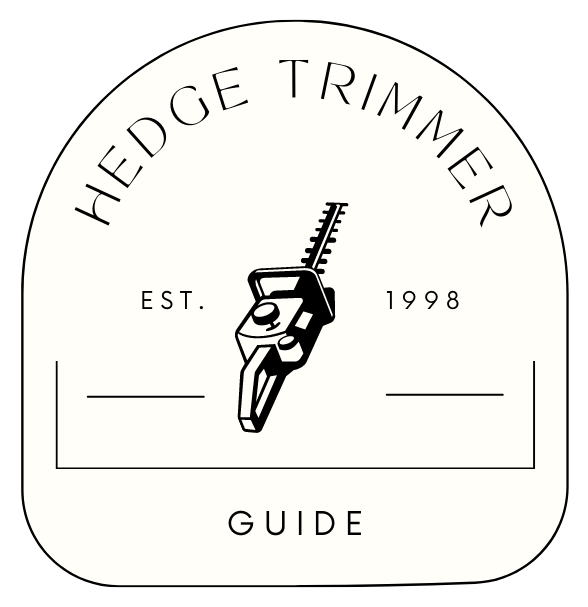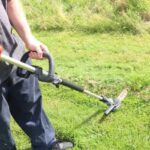So you’ve been feeling really cool using your hedge trimmer, trimming away hedges and solitary shrubs, and making your garden look great. Good for you! However, there might come a time when your hedge trimmer will no longer be as effective as it used to be. This is why today we’ll be sharing with you all about how to sharpen, clean, and replace hedge trimmer blades.
If you consider yourself an avid gardener or wish to become one, a hedge trimmer should become part of your gardening equipment. But just like any other gardening tool, your hedge trimmer needs a little care and attention; sharpening, cleaning, and sometimes replacing blades is part of routine maintenance for your hedge trimmer.
If you want to make sure your hedge trimmer works as efficiently as ever, knowing how to sharpen, clean, and replace hedge trimmer blades, is essential. As intimidating as it may sound, you can become a hedge trimmer pro with the right steps and safety guidelines. Continue reading and find out the right steps to sharpen, clean, and replace hedge trimmer blades.
How to Sharpen, Clean, and Replace Hedge Trimmer Blades FAQs
How often should hedge trimmer blades be sharpened?
Ideally, sharpening should be done before the blades show too many visible signs of wear; it is recommended to sharpen every 50 hours of use. This ensures consistent cutting performance and enables you to enjoy your Hedge Trimmer for as long as possible.
How do you remove resin from hedge trimmer blades?
Wear a long-sleeved shirt and rubber or neoprene gloves, and take the hedge shears outdoors. Dip a rag or sponge in turpentine or solvent, and wipe the blades with the rag or sponge to remove sticky sap. Cleaning the blades outdoors prevents the buildup of harmful fumes from the chemicals.
Can you replace hedge trimmer blades?
Your hedge trimmer’s blades are designed to cut and trim brush. You can quickly fix this issue by loosening the bolts on the blade guide and bending the teeth with pliers. If you require blade replacement, then remove all the locking nuts securing the blades and remove the blade guard and tip guard with the washers.
Is WD-40 suitable for hedge trimmer blades?
Exposure to moisture and improper storage causes rust and corrosion, deteriorating the blade material and reducing cutting power. Keeping the blades clean and lubricated with penetrating oil, such as WD-40, improves the performance and extends the life of your hedge cutters.
How do you clean hedge trimmer blades?
Cleaning your hedge trimmer blades is as simple as wiping them down with soapy water and a cloth after each use. Applying a lubricant to the blades after cleaning them is also recommended. Try not to leave it too long between cleans, and ideally, after every use is best.
How to know if your hedge trimmer needs sharpening?
Is your hedge trimmer no longer as effective as it used to be? This is not uncommon: frequent use blunts the cutter blades, requiring sharpening. The problem may arise from a different issue, though, so check the following symptoms to deduce the likely cause quickly:
- Branches keep getting jammed in the trimmer
- Branches are not cut cleanly
How to Sharpen, Clean, and Replace Hedge Trimmer Blades
How to Sharpen Hedge Trimmer Blades
#1 Clean the Teeth
During use, plant sap and resin accumulate on the cutting apparatus of your hedge trimmer. Remove this dirt with a soft cloth before you start sharpening the blades.
#2 Sharpen your Hedge Trimmer Blades with a Flat File
- Always file towards the cutting edge. The flat file is designed to work only when applied in one direction, and this method ensures a perfectly sharp blade.
- When sharpening your hedge trimmer, try to use the file at the recommended sharpening angle, detailed under Technical Data in the operating instructions for your tool.
- The file is only effective on the forward stroke and should be lifted from the surface when you move it back: avoid “sawing” back and forth on the surface with the file, as this may blunt the cutting edge again.
- It would help if you always were careful not to remove too much material during sharpening: the abrasion limit is 5 mm. If you file off more than this, the material strength may be compromised, rendering your hedge trimmer unusable.
- Use the same number of file strokes for each cutting edge so that all blades are the same length at the end.
Durable Steel File to Sharpen Tools
Constructed of high carbon hardened steel, you can use this flat file for deburring items or taking a sharp edge off with durable coated teeth. It’s a multifunctional tool sharpener that measures 10″.
This deburring tool has an ergonomic design with a comfortable rubber anti-slip grip, so you can safely get the job done.
A double cut on both sides of the flat file makes it a great multipurpose tool for professionals and DIYers alike.
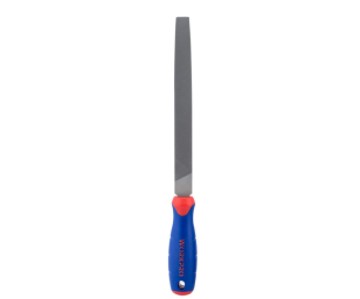
Features:
- Alloy Steel
- Durable Desing
- Comfortable Grip
#3 Remove Burrs using a Whetstone
- Turn the hedge trimmer over so that you can work on the back of the blades, and lightly moisten them as you work.
- Draw the whetstone along each blade, using a careful swiping motion in the direction of the tip and smoothing the roughened surface as you go.
Sharp Pebble Premium Whetstone
This sharpening Water stone kit is exceptionally user-friendly & easy to assemble. Sharp Pebble whetstone uses water for sharpening, so there is no need for expensive sharpening/honing oils.
This whetstone 1000/6000 sharpener kit is highly durable & long-lasting. And it can sharpen any blade out there.
Not all sharpening stones are created equal. It is made using premium quality materials for the manufacturing of our Whetstones.
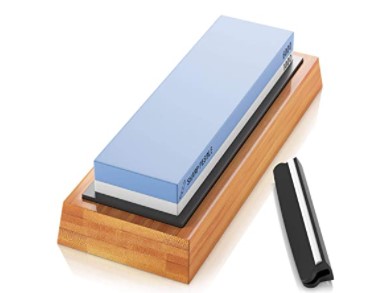
Features:
- Corundum
- Multipurpose
- Easy to Use
#4 Care after Sharpening
First, remove any grinding dust generated in the previous steps. The filing process will have removed the corrosion protection that was previously on the blades, so you next need to spray the cutting apparatus with a resin solvent. This will ensure that the machine continues to function flawlessly and that it will serve you well for a long time to come.
Premium Blade Lubricant
STA-BIL Blade Guard is a premium lubricant that can be used to clean and protect your outdoor tools.
Treating your equipment with this penetrating lube helps maintain the blade edge and keep the tool at its peak performance.
This product not only acts as a shield against rust and corrosion from your favorite tools, but it is also bio-based, meaning that it will not harm your lawn, flowers, or trees.
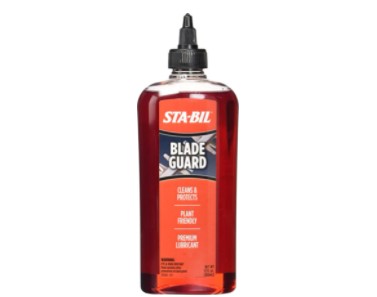
Features:
- Plant Friendly
- Versatile
- Cleans and Protects
How to Clean Hedge Trimmer Blades
Method #1 Soap and Water
- The first step, as always, is going to be around safety. You need to make sure your hedge trimmer is not plugged into the mains or has the petrol engine engaged in any way.
- Safety is always important, so wear gloves. You will be dealing with debris and will need to wipe things off the blade for an effective clean.
- Placing your trimmer on a flat and solid surface will provide you with a safe work environment.
- You should begin the cleaning process by brushing the blades with a relatively stiff brush.
- Make a solution, and then get a stiff brush. Wet the brush, and get to work scrubbing the blades. The soap will often be enough to break through the resin or sap and then remove that sticky substance from the blades.
- After finishing the brush, get a cloth to wipe over the blades. It will help clean away even more debris, primarily if you work on the blade, tooth by tooth. Be careful with the sharp edges, though, so don’t rush things.
- What you then need to do is to make sure you allow the blades to dry. It is an absolute requirement, or rust will develop on the metal, which will affect how they work.
Method#2 Solvent
- If you don’t want to use soap and water, a solvent is a further solution to clean and maintain your blades. Using a solvent to remove the most complex debris is the last resort.
- For this, you should use either alcohol or even diluted bleach. Some people will use a cleaning solvent designed for this purpose.
- As with the soap solution, take the solvent and apply it to a brush or cloth. It is recommended to do this outside to not breathe in too many fumes. The solvent will get to work on breaking down the residue that’s sitting on the blades.
- Once it has dried, lubricate the blades to make sure each piece of metal glides past one another without any problems.
Hedge Trimmer Blade Replacement
#1 Check out your Trimmer
The first thing you have to do is make sure that the hedge trimmer you have can’t be sharpened. If the blade is bolted in, you can sharpen it, and you won’t need to replace it. If it isn’t bolted in, then you know that you can replace it.
#2 Take Out the Old Blade
- Gloves and safety glasses are recommended when working with sharp objects, especially removing and replacing blades.
- Before putting in the new blade, you have to take out the old blade. This is done a little differently depending on the model that you have but typically, there is an eject button you can press to loosen up the blade, and you can carefully wiggle it out.
- If there is no eject button, you turn it and pull it out. Many come with instructions, or you can tell by the area around the blade.
#3 Putting the New Blade In
The final step is to put the new blade in. Again, be careful to make sure that your eyes and hands are covered and then, repeating the way that you removed the old blade, slide in the new blade and secure it.
#4 Test the Blade
Testing the new blade in the air away from other people is an excellent way to ensure that no one will get hurt and that the blade is secure and works properly.
